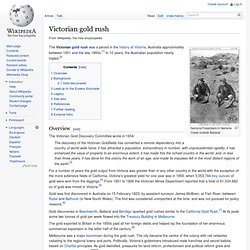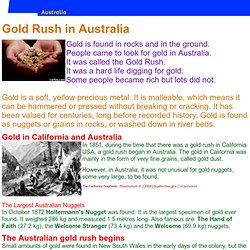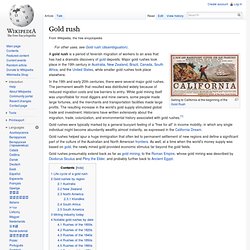

Chinese at the Australian Goldfields. Chinese at the Australian Goldfields At the time that news about the Australian goldrush reached China in 1853, the country had been suffering from years of war and famine.

In order to raise money for the fare to Australia, a man would take a loan from a local trader, agreeing to make regular repayments. His wife and children stayed behind, and worked for the trader if the man was unable to repay the money he had borrowed. To reach Melbourne, it was a journey of several months by ship in cramped conditions. Victorian gold rush. Nerrena Fossickers in Nerrena Creek outside Ballarat Overview[edit] The Victorian Gold Discovery Committee wrote in 1854: The discovery of the Victorian Goldfields has converted a remote dependency into a country of world wide fame; it has attracted a population, extraordinary in number, with unprecedented rapidity; it has enhanced the value of property to an enormous extent; it has made this the richest country in the world; and, in less than three years, it has done for this colony the work of an age, and made its impulses felt in the most distant regions of the earth.[3]

Find, mines, rewards, locations, South Australian Gold Rush. Gold! Gold Rush in Australia Gold is found in rocks and in the ground.

People came to look for gold in Australia. It was called the Gold Rush. It was a hard life digging for gold. Some people became rich but lots did not. Gold is a soft, yellow precious metal. GoldRush. The Australian gold rush. JCF Johnson, A Game of Euchre, col. wood engraving, Australasian Sketcher Supplement [Melbourne], 25 December, 1876.

Image courtesy of the : nla.pic-an8927787. The gold rushes of the nineteenth century and the lives of those who worked the goldfields - known as '' - are etched into our national . There is no doubt that the gold rushes had a huge effect on the Australian economy and our development as a nation. It is also true to say that those heady times had a profound impact on the national psyche. The camaraderie and '' that developed between diggers on the goldfields is still integral to how we - and others - perceive ourselves as Australians. Indeed, mateship and defiance of authority have been central to the way our history has been told. Even today, nothing evokes more widespread national pride than groups of irreverent Aussie 'blokes' beating the English at cricket, or any other sport for that matter!
Australian 1850s Tours Accommodation Groups School Camps Weddings Funtions Venue. Discovery of Gold. Discovery of Gold - A Brief History In 1837, under pressure of a bad drought, Thomas Learmonth and a group of squatters explored the area to the north of their settlement near Geelong in search of better watered regions.

On this journey they reached and climbed Mt. Bonan Yowing (now Buninyong) and were thus the first to see the Ballarat area. In March 1838, two squatters, Yuille and Anderson, settled with their flocks on the banks of an area known as Black Swamp, now Lake Wendouree. Gold Rush, 1852 : About New South Wales. © the State Library of New South Wales Following the first payable gold discovery at Ophir by Edward Hammond Hargraves in 1852, the international rush towards Australia's fledgling gold fields brought 370 000 migrants to Australia in its first year and would greatly alter the social and economic fabric of New South Wales.
These new settlers brought with them new trades and skills, as well as their culturally specific habits, which benefited local economies of gold rush towns. The towns also flourished with the development of sustainable service and manufacturing industries, elevating them beyond the somewhat stagnant farming villages of the past. When the gold rush came to an end in the 1870s, Australia's population had risen from 400 000 to 1.2 million, with many miners choosing to settle in Australia permanently. Eureka! Chinese steelyard scale Mogo Gold Rush Theme Park Hill End Historic Site. Gold rush. Sailing to California at the beginning of the Gold Rush A gold rush is a period of feverish migration of workers to an area that has had a dramatic discovery of gold deposits.

Major gold rushes took place in the 19th century in Australia, New Zealand, Brazil, Canada, South Africa, and the United States, while smaller gold rushes took place elsewhere. In the 19th and early 20th centuries, there were several major gold rushes. The permanent wealth that resulted was distributed widely because of reduced migration costs and low barriers to entry. While gold mining itself was unprofitable for most diggers and mine owners, some people made large fortunes, and the merchants and transportation facilities made large profits. Gold rushes were typically marked by a general buoyant feeling of a "free for all" in income mobility, in which any single individual might become abundantly wealthy almost instantly, as expressed in the California Dream.